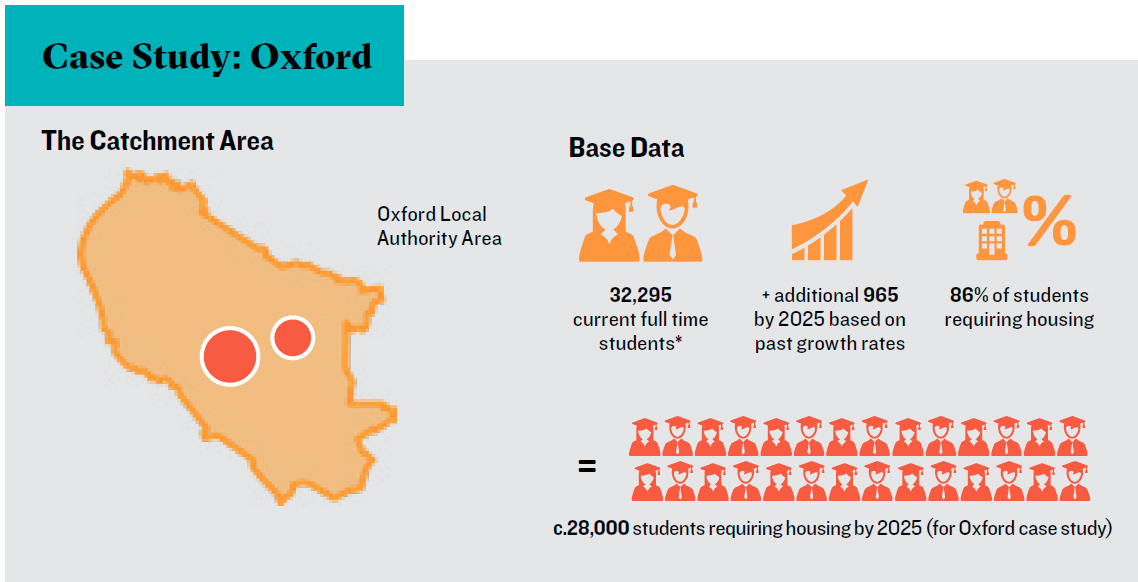Most university locations across the UK have seen an influx of Purpose Built Student Accommodation (PBSA). In response many Local Planning Authorities now require developers to demonstrate the need for this development.
How can Bedspace help?
Bedspace strengthens the justification for PBSA by:
- Presenting evidence led quantitative analysis of current and past trends in student growth and student accommodation preferences;
- Analysing the supply pipeline as well as the potential future capacity for further PBSA, cognisant of both past trends and of university growth ambitions;
- Detailing the potential economic impacts generated during construction of the development and after its completion; and
- Presenting this assessment in a planning application document which has proven track record with Local Authorities.
Who is it for?
- PBSA Developers: Demonstrating the need for PBSA in a given University location or informing early investment decisions;
- Local Planning Authorities: Understanding student accommodation needs in their area and providing robust evidence for emerging development plans; and
- Higher Education Institutions: Understanding the mix of student accommodation in their area and informing expansion of their accommodation offer.
Bedspace features two examples of student base data in local authorities, one of which is Oxford City Council (OCC). The need to deliver general housing, whilst ensuring student accommodation is provided for during the plan period, is acutely relevant to OCC, and thus presented an interesting case study.
It has been identified that in the catchment area of Oxford City there are 32,295 students, split between its two universities; Oxford University (19,265) and Oxford Brookes University (13,035)
[1]. If the city’s student population was to increase in line with past growth rates over the last 10 years, there could be an additional 965 students by 2025. Unsurprisingly, our evidence also shows that in Oxford, university halls of residence are the preferred accommodation type (over 50%). With 25% of students living in private rented accommodation, private sector halls represent only a very small fraction of the share (3%).
The Council’s recently adopted Local Plan (June 2020) recognises that the success of Oxford’s economy is shaped by the presence of its two universities.
The Local Plan identifies that provision of good quality, well managed student accommodation will continue to be required in Oxford. However, this type of land use often competes with sites for general housing. The Local Plan therefore places restrictions on the locations suitable for student accommodation and limits its occupancy to students at one of the two universities on academic courses of over a year.
OCC’s approach has been to include a threshold cap for both universities within the Local Plan. This restricts the number of students permitted to live outside the university provided accommodation. Furthermore, in the OCC area, the growth, redevelopment or refurbishment of education floorspace is linked to student accommodation provision (i.e. the provision of accommodation must be in step with the expansion of student places).
The above, coupled with the requirement to provide an affordable housing contribution on student accommodation schemes (25 or more students/10 or more self-contained units), as well as payment of CIL (which is applicable to both education and student accommodation floorspace in the OCC area), presents a challenging situation for PBSA.
However, the unique nature of OCC’s threshold strategy for the universities is long established. The Local Plan Inspector noted in its Examination Report (May 2020
[2]) that
“…..the threshold system has been tried and tested in Oxford in previous plans and is a workable means of balancing the housing needs of the very large student population against the city’s many other housing needs and land uses. It is also a system that, subject to the specific threshold numbers, has been developed by consensus.”
Given the importance of the universities within the area, supply for student accommodation needs to be met to ensure growth of these important institutions can continue. The Local Plan’s aim is to balance support for the two universities while continuing the prioritisation of general housing. This difficult balancing act is applicable to local authorities across the UK.
Clearly PBSA is one of many competing land uses that Local Authorities have to contend with when seeking to meet its housing requirements. The shortage of appropriate sites within the city is a factor in land supply for housing. For example, Oxford has a rich history with large swathes of the city core within or adjacent to Conservation Areas, many listed buildings and other heritage assets. This is common across several of the UK’s university towns and cities. By nature, student accommodation would ideally be located in areas accessible to the city centre as opposed to outer suburbs, which may be more suitable for general housing provision. If students living within private rented accommodation could be housed in PBSA, private housing could be released back into the general rental market.
The National Planning Practice Guidance (NPPG
[3]) confirms that all student accommodation can in principle count towards contributing to an authority’s housing land supply based on:
- the amount of accommodation that new student housing releases in the wider housing market (by allowing existing properties to return to general residential use); and / or
- the extent to which it allows general market housing to remain in such use, rather than being converted for use as student accommodation.
PBSA development could go some way to assist with these challenges, allowing institutions to focus investment in teaching facilities and the “student experience” rather than provision of accommodation.
New PBSA development presents a fresh opportunity in terms of the way it can be used, which will be increasingly important in an uncertain market (See Arwel Evans'
blog). This flexibility could help with other competing land uses, not just for general housing sites. For example, PBSA space can be rented on a short-term basis to visitors outside of term time, helping to address a shortage of visitor accommodation.
Bedspace can help navigate some of the current uncertainty in the market and provide a robust evidence led argument, helping to guide investment decisions to where PBSA is most needed.
Please do not hesitate to
get in touch to discuss further.

[1] HESA Student Record 2018/19 (figures do not sum due to rounding)[2] https://www.oxford.gov.uk/downloads/file/7288/inspectors_report_-_oxford_local_plan_2036[3] https://www.gov.uk/guidance/housing-supply-and-delivery Paragraph: 034 Reference ID: 68-034-20190722





